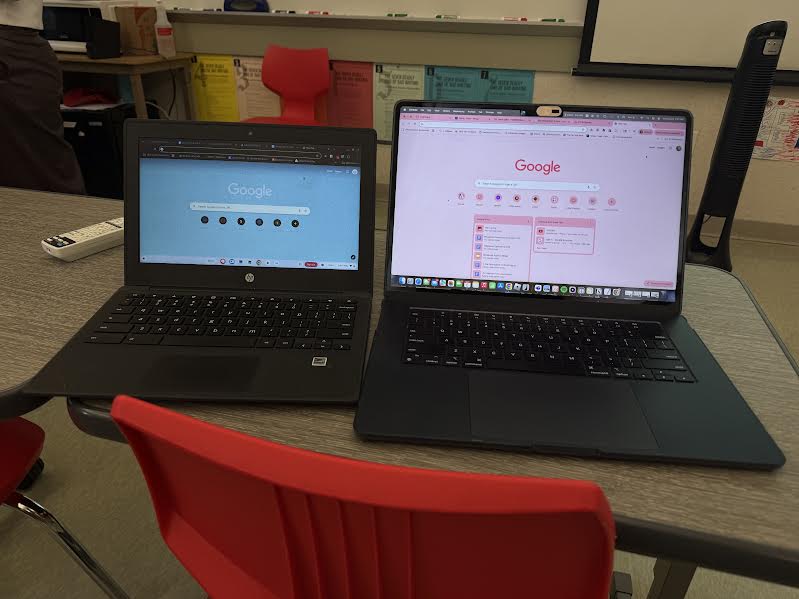Nowadays, it is very rare that you know someone who doesn’t have a phone. As time goes on, new devices of electronics are being introduced into the world. Young generations latch onto the idea of having to own an electronic device to be able to connect with the world.
According to the Child Mind Institute, a nonprofit organization dedicated to help children struggling with mental health and learning disorders, their studies claimed that 40% of kids at the young age of 10 years old already have a smartphone. By the age of 12 it increases to 71%. The percentage skyrockets to almost 100 percent, at 91% of 14 year olds with a smartphone. As we all continue to adapt to the new technology developments and advancements, we need to pause, and pay attention to the potentially serious side effects that technology has on new generations, especially generations that have been exposed to technology since birth. Because technology is changing daily, it has been hard for researchers to fully collect data that connects technology, specifically social media, to the growth in mental illnesses in people (especially teenagers) but there is plenty of evidence that can be gathered that can back up the claim that it can definitely be a factor.
It is without doubt that before technology, people back then would spend their time differently then how people spend their time now. As technology evolves, so does the adaptation of social media. According to Investopedia, the world’s leading source of financial content on the web, social media is, “a variety of technologies that facilitate the sharing of ideas and information among their users,” and Generation Z’s are the generation that have been most negatively affected from it. The McKinsey Health Institution states that, although social media is a resourceful way of communicating with one another, the addiction of social media can make an individual start looking at the world or even themselves differently: “ … [A] new global survey said social media usage can lead to a fear of missing out (FOMO) or poor body image, but it also can help with social connections and self-expression…Gen Zers, on average, are more likely than other generations to cite negative feelings about social media. They are also more likely to report having poor mental health.”
Because social media has become such a prominent way to get news and catch up with friends and families, we sometimes don’t realize how a lot of consumption of social media can lead to having negative and intrusive thoughts of yourself or others. Many can’t go a day, hours, or even minutes without getting on social media, and it is because they have wired their minds to become dependent on getting dopamine or serotonin from this type of technology, which is extremely similar to how drug addicts feel about their drug(s). Gen Z is not the only generation that has been affected by technology, but so has Generation Alpha, which ranges from the years of 2010/2012-2025.
Gael Contreras, a junior at SRHS, said that he personally finds himself “doom scrolling.” Doom scrolling is scrolling on your phone without realizing how much time you’ve gone scrolling. It can be addicting to some people because scrolling “activates the brain’s reward center by releasing dopamine, a ‘feel-good chemical’ associated to pleasure and reward,” according to “Unplugged,” an app created by two entrepreneurs, Hector and Ben, to help those that find themselves addicted to social media get a break, camp out in one of their cabins near your city and connect with nature. Doom scrolling can lead to both physical and mental concerns because physically, you can find yourself being unproductive, get eye strains, and neck problems. Mentally, when you are excessively scrolling for too long, you are exposing yourself to all different types of topics on the internet, some which might bring you concern, anxiety, and/or stress.
Generation Alpha is the generation that has already been born into the world of highly developed technology and has adjusted to the normality of using technology for their every need, as said so by therapist.com, a website that helps individuals find mental health therapists that meet their exact needs,“Generation Alpha will grow up with more digital technology than any previous generation. Streaming, voice activation, social media, and smartphones are now standard parts of life.” During the world wide shut down due to the pandemic of COVID-19, there was also more of an increase in the high adaptation and dependence on electronic devices, most of all phones, but even without the shutdown, Generation Alpha would have either ways still been dependent on technology prior to any other generation.
I, Ana Rodriguez, have an 8 year old sister, Olivia Rosales, who was born into the world of technology. She was introduced to electronics at an early age and was recently given her first IPhone. Any kid, just like her, has the curiosity of finding out what social media is and they want to be included in it which has left her with downloading apps such as Youtube and TikTok.
Her dependance and entertainment to her phone has become extreme to the point where she constantly struggles to stay focused and engaged on her schoolwork because of her necessity to be on her phone at all times. Anytime she’s on her phone, it is hard to get her attention and a response from her, making our parents and myself have to yell out her name about 3-5 times. A factor that also plays a role in her excessive use of social media is her diagnosis of ADHD, a chronic condition that causes the brain to get easily distracted, is impulsive, and is hyperactive. Though studies have shown that extreme use of technology and social media doesn’t actually lead to one developing ADHD, there is a connection between the two.
According to the National Library of Medicine, studies made between adolescents with and without ADHD, showed that the youth with ADHD who specifically incorporate gaming into their addiction with technology, use it as a vulnerability to the immediate feedback it gives off. Such games are made and played as a way “to get to the next level” which makes it a reward to people with ADHD. Video games have shown to increase dopamine release activating this reward sense.
Similarly to Ana’s sister’s case, I, Martha Gonsalez, have an eleven year old brother, Sebastian Moreno, who has struggled with ADHD symptoms for years. But just last year, in 2023, he was officially diagnosed with it. I’ve noticed that when he has to work on homework, he gets easily distracted and he has to constantly be moving around. I also noticed that his ADHD symptoms seem to worsen when he is not on his tablet. “Playing Roblox distracts me and makes me not want to walk around and touch everything. So when I don’t have my tablet, I am bored and [wander off].” His ADHD is a factor to his anxiousness and jitteriness when not being on his tablet, but these symptoms were also similar to nomophobia. Nomophobia is the fear of not having access to your smartphone and/or other technological devices. Like nomophobia, others struggle with a similar addiction to social media. According to Addiction Center, a web guide for those who are struggling with co-occurring substance abuse and mental health disorders, social media addiction is a behavioral addiction that is characterized as being overly concerned about social media, driven by an uncontrollable urge to log on to or use social media, and devoting so much time and effort to social media that it impairs other important life areas. The behavior that each condition has in common–impulsivity and distraction.
When speaking to Sebastian, he said that technology, specifically games, actually helps him calm down his ADHD symptoms. “When I am on my tablet, I get entertained and it helps me not move around too much,” Sebastian said. This is a perspective that technology in this case is an alternative ‘fidget toy’ for someone who struggles with ADHD. However, this might not be the result for everything.
In a Harvard Health article, “Can cell phone use cause ADHD?,” Claire McCarth, a pediatrician at Boston Children’s Hospital and an assistant professor of pediatrics at Harvard Medical School, talks about the notable attachment that the majority have on their phones and how much this generation has relied on technology. She interviewed 3 groups of people with ADHD, some that don’t use technology, others that use it here and there, and another group who frequently use it. She noticed that those who used their cell phones the most, had more severe ADHD symptoms. “They found that 4.6% of teens who didn’t report any high-frequency use of digital media had symptoms of ADHD at the end of the study — but that number jumped to 9.5% of those who reported seven high-frequency activities, and 10.5% for those who reported frequent activity in all 14. Overall, frequent digital media use appeared to increase the risk of having symptoms of ADHD by about 10%.” Comparing the use of technology between Sebastian and the students Harvard used in their study, the difference is that Sebastian used technology to play games and the Harvard students were using their cell phones and digital media/social media. This evidence proves that social media can take a bigger toll in the human brain, but especially in younger, adolescent brains that are in the process of development.
Noticing how much technology and social media has expanded, including the many forms of technology there are, San Rafael High School History teacher Ms. Sulem believes that students have a great amount of access to technology, more than they need, “Social media comes in between students’ education […]students get the urge to regularly check their phones.”
Junior student Danna Florencio uses social media on a daily basis, whether it’s Snapchat to communicate with friends or Youtube, for entertainment purposes. She believes she isn’t addicted to social media but she definitely thinks social media comes in between her and her education. “I often catch myself laying in bed scrolling on social media, while I should be studying or working on homework…I would say technology affected my freshman year [the worst] and to this day, I’m paying the price for that.”
“Ten times out of 10, my peers are scrolling on social media and absorbed in their phones which prevents them from doing class work or finishing assignments that are due in class time. So it causes them to fall behind leading to further troubles for them,” shared senior student Bela Temple.
There have also been many cases in Ms. Sulem’s teaching years where she has noticed and caught students of hers using many tools off the internet to complete the work for them, such as AI, a form of technology that allows computers and machines to stimulate real life human intelligence and problem solving. AI doesn’t necessarily provide students with any information, instead straight up gives them the answer they are looking for, without students actually being able to interpret the knowledge they learn in class and instead use the answers they are being given. Since many take advantage of this technology and don’t put their knowledge to use, she believes that students do not value the actual meaning of their education.
The mental health therapist, Paulina Montes, from the Wellness Center at San Rafael High School, said that from working at SRHS for two years, the most common reasons students come to the Wellness Center are due to anxiety, stress, and interpersonal problems. When I (Martha) asked her if there were ever students that would appear in the Wellness Center because of social media causes, she replied saying, “Yes definitely! Technology and social media are very much woven into our lives. We use it to connect with other people so issues and conflicts can and do come up.” She continued by speaking about how social media is a helpful way of connecting people together and building a community, “as long as it is one of multiple ways to be connected with others then it’s ok.”
Judy Schwerin, the SRHS Wellness Center coordinator, has been working at SRHS for 4 years and says that post-COVID, she noticed an influx of adolescent social emotional behaviors like anxiety, elevated depression, panic disorders, dysregulation, and post-traumatic stress concerns. When speaking about social media and technology specifically, she said that some of the students ‘social emotional behaviors’ are caused by their use of either one or both. “ We currently are supporting students with many different issues and unfortunately one of them is cyberbullying.” Like Ms. Monte’s thoughts’ on social media, Ms. Schwerin had similar ideas on social media. “Technology isn’t going anywhere and technology has also given us the ability to achieve a lot of cool things. That being said, it is so important, especially as the adolescent brain continues to develop, for young people to have a healthy understanding about the relationship between emotional health and digital habits.”
Backtracking to the increase of phone usage during the pandemic, students had to learn to dissociate from the idea of having their phones at every moment when coming back to in person school. The parting ways with technology did not occur once school began because chromebooks were given out to every student. Chromebooks were given out specifically as a tool for school work, but teachers became aware of the distractions chromebook brought to students and how at times they were in no way helping students leave the habit of being on technology 24/7. “This technology [Chromebooks] is very helpful in the classroom when we do research or if I want students to do online assignments. The problem I have seen grow in the last few years is how often students will get distracted from work and will end up playing games on the chromebook or watching videos[…]This was not a thing that we faced as much before 2020,” said Ms. Khuele, History teacher at SRHS.
“When you throw in Chromebooks… everything has been reshaped. The most noticeable impacts on students are a sharp decline in attention spans and fundamental unwillingness to do anything that requires reading/writing,” said Mr. Allen, another teacher of the History department.
The trends that the SRHS community has noticed due to technology and social media has clearly left them with awareness. School admin tried helping students detach from their phones since the beginning of the school year by having teachers set up phone pouches for students to place their phones, with an email sent to all saying, “ Each and every day, all students and staff will take a break from the temptations of their cellphones and social media during class time and meetings. Students will place their phones in a classroom pocket carrier for the duration of the period. Students seen using their phone during class time will have it locked away for the remainder of the day…In post-lockdown life we have seen a troubling addiction to phones that I believe we need to interrupt while on campus. In fact, the Surgeon General recently issued a new advisory about the effects of social media on youth (link) which we are prepared to address this year.”
The phone pouches were consistent for a while, however, Ana and I (Martha) both made observations that in the majority of our classes, our classmates, including ourselves, later in the school year, stopped putting our phones in the phone pouches, and since the school never made doing so an enforced requirement as opposed to a suggestion, there was really no reason not to keep phones in purses or backpacks or pockets.
Though technology and social media are helpful tools in some ways for individuals to connect with each other, it overall has a negative impact on young generation’s perspective of themselves. Some use social media for communicational reasons but some rely on it too much for other entertainment purposes. This can come in between the attentiveness of teenagers and newer generations.







































